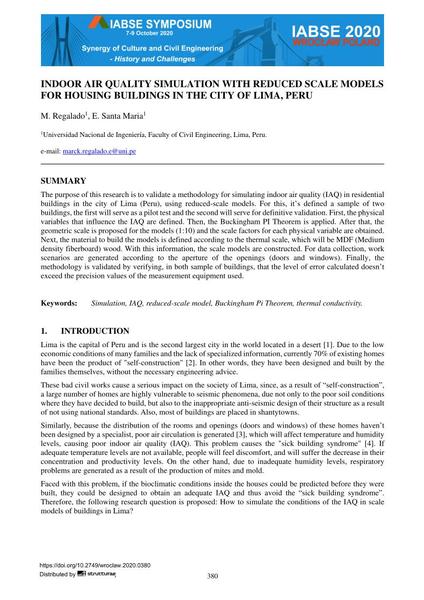Indoor Air Quality Simulation with Reduced Scale Models for Housing Buildings in the City of Lima, Peru

|
|
|||||||||||
Bibliografische Angaben
| Autor(en): |
M. Regalado
E. Santa Maria |
||||
|---|---|---|---|---|---|
| Medium: | Tagungsbeitrag | ||||
| Sprache(n): | Englisch | ||||
| Tagung: | IABSE Symposium: Synergy of Culture and Civil Engineering – History and Challenges, Wrocław, Poland, 7-9 October 2020 | ||||
| Veröffentlicht in: | IABSE Symposium Wroclaw 2020 | ||||
|
|||||
| Seite(n): | 380-389 | ||||
| Anzahl der Seiten (im PDF): | 10 | ||||
| Jahr: | 2020 | ||||
| DOI: | 10.2749/wroclaw.2020.0380 | ||||
| Abstrakt: |
The purpose of this research is to validate a methodology for simulating indoor air quality (IAQ) in residential buildings in the city of Lima (Peru), using reduced-scale models. For this, it’s defined a sample of two buildings, the first will serve as a pilot test and the second will serve for definitive validation. First, the physical variables that influence the IAQ are defined. Then, the Buckingham PI Theorem is applied. After that, the geometric scale is proposed for the models (1:10) and the scale factors for each physical variable are obtained. Next, the material to build the models is defined according to the thermal scale, which will be MDF (Medium density fiberboard) wood. With this information, the scale models are constructed. For data collection, work scenarios are generated according to the aperture of the openings (doors and windows). Finally, the methodology is validated by verifying, in both sample of buildings, that the level of error calculated doesn’t exceed the precision values of the measurement equipment used. |
||||
